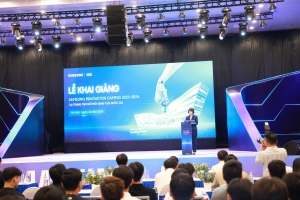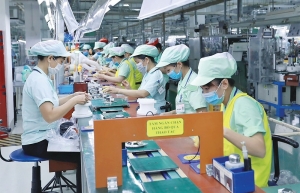Semiconductor arena can improve with tax incentives
Vietnam has been emerging as a significant player in the global semiconductor industry and aimed to become a key market for large-scale chip production. However, the country faces an intense competition from regional and global rivals such as South Korea, Malaysia, and Thailand, each offering attractive incentives to lure semiconductor investments.
| Nguyen Hung Du, partner and head of Tax Practice Rajah & Tann LCT |
To compete effectively, Vietnam has been considering leveraging strategic incentives to attract foreign semiconductor players and develop a robust local semiconductor workforce as well.
South Korea extended its K-Chips Act that provides substantial tax incentives to investments in advanced industries for another three years. This act is a critical part of South Korea’s strategy to maintain its competitive edge in the semiconductor market.
Malaysia, on the other hand, has been building Southeast Asia’s largest integrated circuit design park and offers a comprehensive package of incentives including tax breaks, subsidies, and visa exemptions to draw in global tech companies, corporate and individual investors, and talents globally. Meanwhile, Thailand offered tax breaks, land subsidies, and workforce development support to attract chip manufacturers.
To position itself competitively, Vietnam has been considering improving tax policies that are not only attractive but also sustainable. Vietnam has offered substantial corporate income tax (CIT) incentives for semiconductor research and development (R&D) and production, including a four-year tax exemption, a 50 per cent tax reduction for nine subsequent years, and a preferential tax rate of 10 per cent for 15 years from the licensing date.
Additionally, customs duty exemptions are provided for imported goods for high-tech projects, including specialised transportation and construction materials.
Vietnam has also established a National Innovation Centre and three high-tech industrial zones in Ho Chi Minh City, Hanoi, and Danang. These zones create an ecosystem conducive to investment and development in semiconductor R&D and production. Vietnam has also been studying the experiences of many countries in establishing tax incentive policies for the high-tech industry.
Common tax incentives for high-tech are granted by many countries, including CIT incentives, workforce incentives under a personal income tax (PIT) regime, incentives in applying VAT to products, and customs import duty. Incentives are set out by some countries, such as conditional tax liabilities reduction, high rate of R&D cost for tax deduction, lower CIT rate for high-tech schemes, reduction in tax and social security contribution in the high-tech industry, and more besides.
To step up its game, Vietnam should consider several tax policy improvements.
- Enhanced tax incentives: Vietnam should introduce an open policy to optimise a tax incentive regime for the semiconductor industry by improving tax administrative procedures. Furthermore, this could include extended CIT exemptions for specific projects in line with the growth plan of the high-tech industry, higher R&D tax credits, and additional deductions for training and workforce development costs.
- Investment support fund: Establishing an investment support fund, financed by the collection of a top-up tax of 15 per cent on multinational groups subject to the global minimum tax (GMT) application, could provide targeted support to high-tech enterprises. This fund would stabilise the investment environment and attract strategic foreign investors, especially in the semiconductor sector.
- Incentives for workforce development: To build a 50,000-strong semiconductor workforce by 2030, Vietnam should offer tax incentives for companies investing in workforce training and development. This could include PIT exemptions for experts and skilled workers in the semiconductor industry, and grants or subsidies for companies that invest in training programmes. Tax policies play a crucial role in developing a local semiconductor workforce. By offering PIT exemptions and reductions for semiconductor experts and skilled workers, Vietnam can pull in top talents from around the world.
- Support for equipment and technology: Providing specific support for equipment purchase and technology transfer can further reduce the entry barriers for semiconductor companies. For example, offering subsidies that cover up to 5 per cent of total equipment costs and facilitating technology acquisition through tax credits or direct grants would make Vietnam a more attractive destination for semiconductor investments.
Vietnam’s ambitious plan to develop a significant semiconductor workforce requires a coordinated effort between the government and the private sector. Tax incentives can lower the cost for companies investing in training and education, making it easier to attract and retain skilled workers. This, in turn, enhances the overall competitiveness of Vietnam’s semiconductor industry.
Vietnam’s future tax policy for the semiconductor industry should focus on creating a favourable investment climate while ensuring long-term sustainability. The upcoming reform of tax policies related to the GMT and the establishment of an investment support fund are steps in the right direction. Additionally, specific incentives for semiconductor projects will further bolster Vietnam’s position in the semiconductor market.
| Call to arms for semiconductor roles Chip design is set to boom in Vietnam in the coming years, with many investors entering the market. However, human resource training needs more backing for the industry to achieve high quality and capture opportunities. |
| Vietnam to become key link in semiconductor value chain The Vietnamese government provided positivity and expectation for the country to develop its semiconductor industry at a pivotal conference on April 24 focusing on human resource development. |
 | Samsung and NIC to train 200 students Samsung and the National Innovation Centre (NIC) kicked off the Samsung Innovation Campus (SIC) in Hoa Lac Hi-tech Park on May 3, with six training courses for 200 students. |
| Semiconductor success in reach with investment During the InnovaConnect event organised in April, Lee Young Hee, director of the Center for Integrated Nanostructure Physics at the Institute for Basic Sciences at Sungkyunkwan University, and Park Inkyu, head professor at the Department of Mechanical Engineering at the Korea Advanced Institute of Science and Technology, shared their insights with VIR’s Hoang Minh about Vietnam’s advantages in developing the semiconductor industry, as well as trends in the industry that the nation should pursue. |
 | Technology giants keen to embrace gifted engineers Many excellent Vietnamese students could soon have opportunities to improve their knowledge and work in microchips and semiconductors at research and development centres of tech groups such as Samsung and Hana Micron. |
 | Vietnam welcomes Indian interest in hi-tech and semiconductor sectors The Vietnamese government opens its arms to Indian entrepreneurs and businesses to invest in high-technology, semiconductors, and digital technology, according to Deputy Minister of Information and Communications Bui Hoang Phuong. |
What the stars mean:
★ Poor ★ ★ Promising ★★★ Good ★★★★ Very good ★★★★★ Exceptional
Related Contents
Latest News
More News
- Main drivers for Vietnam’s digital economy future (December 03, 2025 | 11:35)
- Pivotal stage of growth paves way for rise in M&As (December 03, 2025 | 10:00)
- Positive projections for M&A interest from Thailand (December 03, 2025 | 09:40)
- Manifesting the first line of defence in cybersecurity (December 03, 2025 | 09:00)
- The transformational role AI can play in accounting arena (December 03, 2025 | 08:00)
- Unlocking 5G-AI potential in Singapore (December 03, 2025 | 08:00)
- Data-driven strategies vital for a fast-evolving nation (December 02, 2025 | 09:41)
- Policy to practice: how Vietnam can lead the region (November 26, 2025 | 16:03)
- Mobilising private capital at scale vital for climate battle (November 26, 2025 | 15:36)
- VILAF and Yoon & Yang launch Vietnam - Korea Practice Unit (November 26, 2025 | 15:16)

 Tag:
Tag:


















 Mobile Version
Mobile Version